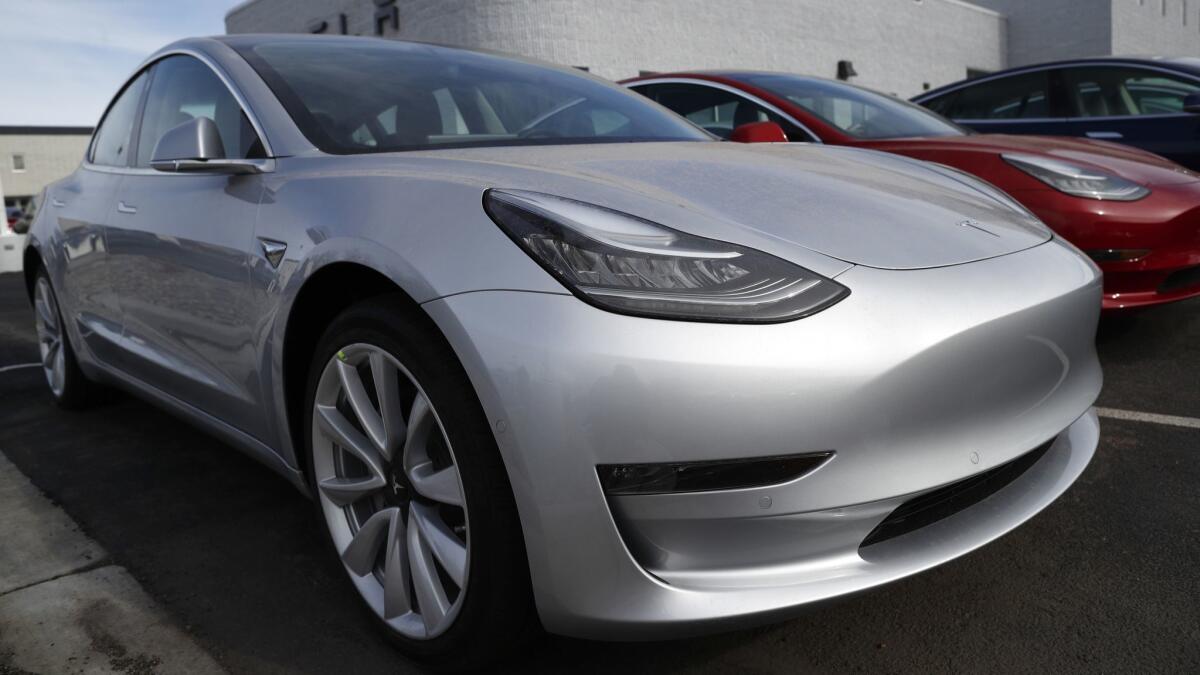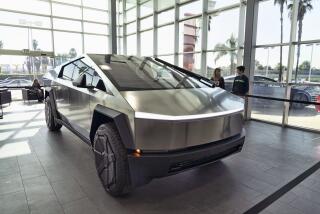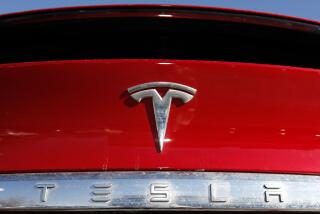Consumer Reports embraces Tesla’s Model 3, recommending the car after Tesla fixes brake issue

Reporting from San Francisco — Days after Consumer Reports ripped Tesla Inc.’s new Model 3 electric sedan for substandard brake performance, Tesla issued a fix — and Consumer Reports now recommends the car.
Consumer Reports originally recommended against buying the Model 3 in a review published May 23, largely because in its brake tests, the car traveled a relatively long way before stopping. It retested the car after Tesla provided an over-the-air software fix for all Model 3s and said Wednesday that stopping distance had improved dramatically — by nearly 20 feet.
For the record:
12:25 p.m. May 30, 2018An earlier version of this article reported that in its retest, Consumer Reports found the Tesla Model 3’s stopping distance to be 132 feet. It was 133 feet.
It’s not uncommon for manufacturers to make fixes after receiving bad reviews, the head of automobile testing at Consumer Reports, Jake Fisher, told The Times. What’s groundbreaking, Fisher said, is the way the brake problem was remedied: through Tesla’s over-the-air software update system.
Tesla recalibrated the brakes by remote control, streaming data to Model 3 computers in a manner roughly analogous to the way Spotify streams songs to a smartphone.
“We very often find deficiencies in vehicles,” Fisher said. “What’s unique is how quickly they’re able to react.”
In the May 23 review, Consumer Reports said: “Tesla’s stopping distance of 152 feet from 60 mph was far worse than any contemporary car we’ve tested and about 7 feet longer than the stopping distance of a Ford F-150 full-sized pickup.”
After the update, stopping distance was 133 feet, compared with 135 feet for an Audi A4 and 132 feet for a BMW 3-series, two gasoline models to which the electric Model 3 is often compared.
To test the brakes, a driver stomps hard on the brake at 60 mph, and the stopping distance is measured. Consumer Reports said it repeated the test several times on two different Model 3 vehicles.
Although most automakers offer limited over-the-air services — emergency assistance, for instance — Tesla is the only one that regularly updates major vehicle systems with fixes and new features this way.
“If this were another automaker, there might be recalls, or service bulletins, and owners would have to take their cars in to get them fixed,” Fisher said.
Last week, Fiat Chrysler recalled 4.8 million vehicles to fix a software glitch that could prevent a driver from disengaging cruise control. (The Tesla brake fix was voluntary. Government officials did not raise safety issues or order a recall.)
All automakers are developing similar systems, but unlike Tesla, they must remake “legacy” automobile network systems that reach decades back into the 20th century.
“It’s an uncomfortable position for automakers,” said Mark Wakefield, managing director at consulting firm Alix Partners.
As automakers develop remote-update systems, customer privacy and fear of hackers are two big issues that give them pause. “The risk is that someone [unauthorized] can remotely know where you are and, even worse, take some control of the car,” Wakefield said. “Theoretically, someone could slam on the brakes at the push of a button.”
But when Tesla began offering over-the-air updates, it was a “wake-up call” for the industry, which is now scrambling to catch up, Wakefield said.
There’s plenty of incentive for automakers to embrace such software. Vehicles that can receive data wirelessly will increasingly resemble smartphones on wheels, with all the opportunities for revenue generation that implies: selling apps, charging for data, pumping advertising into the car, and probably new paid services no one has thought of yet.
Timo Littke, business development manager for over-the-air software at Here — a mapping and location company majority owned by Audi, Daimler and BMW — said automakers must balance innovation with safety and privacy. “The smartphone usually won’t put people’s lives in danger, but a car update can do that,” he said.
Tesla’s brake fix illustrates how safety and performance upgrades can be sent directly to a vehicle with no need to visit a dealer or repair shop.
The basic mechanism of disc brakes, like those on the Model 3, is simple: A pair of calipers clamps down on both sides of a spinning metal disc.
But “it’s not just a matter of ultimate clamping force,” Fisher said. With the advent of anti-lock brakes in the 1970s, computer code began playing an increasingly crucial role in brake calibration.
“It’s a matter of how the software determines the maximum force that is used to stop the vehicle but prevent a skid,” Fisher said. “A good system will feel the impending lockup and allow just enough slide so you still maintain control but get maximum stop.”
Dozens of variables are weighed when an automaker sets the base calibration for a car’s brakes. Fisher couldn’t say why Tesla didn’t calibrate the Model 3 to meet the Consumer Reports test requirements from the start. “Depending on how well the software is written, it could make a big impact on the [stopping] distance,” he said.
Tesla declined to make an executive available to discuss the company’s over-the-air update feature. Chief Executive Elon Musk tweeted: “Really appreciate the high quality critical feedback from @ConsumerReports. Road noise & ride comfort already addressed too. [User interface] improvements coming via remote software update later this month.”
In its original review, Consumer Reports also criticized the Model 3’s 15-inch computer touchscreen, where nearly all the vehicle’s controls reside.
The layout “forces drivers to take multiple steps to accomplish simple tasks,” which “can cause driver distraction because each act forces drivers to take their eyes off the road and a hand off the steering wheel,” Consumer Reports said.
But the review also raved about the electric car’s “record setting” range and “acceleration and handling that could make it a healthy competitor to performance-oriented cars such as BMW’s 3 Series and the Audi A4.”
Twitter: @russ1mitchell
UPDATES:
12:35 p.m.: This article was updated with a tweet from Elon Musk.
12:25 p.m.: This article was updated with the stopping distances of other vehicles.
10:45 a.m.: This article was updated with comments from Mark Wakefield and Timo Littke.
This article was originally published at 9:25 a.m.







